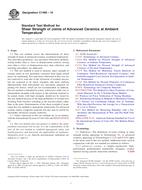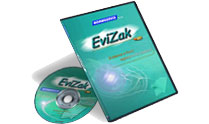Potrebujeme váš súhlas na využitie jednotlivých dát, aby sa vám okrem iného mohli ukazovať informácie týkajúce sa vašich záujmov. Súhlas udelíte kliknutím na tlačidlo „OK“.
ASTM C1469-10
Standard Test Method for Shear Strength of Joints of Advanced Ceramics at Ambient Temperature
Automaticky preložený názov:
Štandardná skúšobná metóda pre šmyku škár pokročilých keramiky pri izbovej teplote
NORMA vydaná dňa 1.12.2010
Informácie o norme:
Označenie normy: ASTM C1469-10
Poznámka: NEPLATNÁ
Dátum vydania normy: 1.12.2010
Kód tovaru: NS-11411
Počet strán: 8
Približná hmotnosť: 24 g (0.05 libier)
Krajina: Americká technická norma
Kategória: Technické normy ASTM
Anotácia textu normy ASTM C1469-10 :
Keywords:
asymmetrical four-point test, ceramic joint, ceramics, shear force, shear strength, Advanced ceramics, Ambient temperature, Asymmetrical four-point test, Ceramic joints, Displacement, Force, Geometric analysis, Joints, Shear testing--ceramics, ICS Number Code 81.060.30 (Advanced ceramics)
Doplňujúce informácie
| Significance and Use | ||||||||||||||||||||||||
|
Advanced ceramics are candidate materials for structural applications requiring high degrees of wear and corrosion resistance, often at elevated temperatures. Joints are produced to enhance the performance and applicability of materials. While the joints between similar materials are generally made for manufacturing complex parts and repairing components, those involving dissimilar materials usually are produced to exploit the unique properties of each constituent in the new component. Depending on the joining process, the joint region may be the weakest part of the component. Since under mixed-mode and shear loading, the load transfer across the joint requires reasonable shear strength, it is important that the quality and integrity of joint under in-plane shear forces be quantified. Shear strength data are also needed to monitor the development of new and improved joining techniques. Shear tests provide information on the strength and deformation of materials under shear stresses. This test method may be used for material development, material comparison, quality assurance, characterization, and design data generation. For quality control purposes, results derived from standardized shear test specimens may be considered indicative of the response of the material from which they were taken for given primary processing conditions and post-processing heat treatments. |
||||||||||||||||||||||||
| 1. Scope | ||||||||||||||||||||||||
|
1.1 This test method covers the determination of shear strength of joints in advanced ceramics at ambient temperature. Test specimen geometries, test specimen fabrication methods, testing modes (that is, force or displacement control), testing rates (that is, force or displacement rate), data collection, and reporting procedures are addressed. 1.2 This test method is used to measure shear strength of ceramic joints in test specimens extracted from larger joined pieces by machining. Test specimens fabricated in this way are not expected to warp due to the relaxation of residual stresses but are expected to be much straighter and more uniform dimensionally than butt-jointed test specimens prepared by joining two halves, which are not recommended. In addition, this test method is intended for joints, which have either low or intermediate strengths with respect to the substrate material to be joined. Joints with high strengths should not be tested by this test method because of the high probability of invalid tests resulting from fractures initiating at the reaction points rather than in the joint. Determination of the shear strength of joints using this test method is appropriate particularly for advanced ceramic matrix composite materials but also may be useful for monolithic advanced ceramic materials. 1.3 Values expressed in this test method are in accordance with the International System of Units (SI) and . 1.4 This test method does not purport to address the safety problems associated with its use. It is the responsibility of the user of this test method to establish appropriate safety and health practices and determine the applicability of regulatory limitations prior to use. Specific precautionary statements are noted in 8.1 and 8.2. |
||||||||||||||||||||||||
| 2. Referenced Documents | ||||||||||||||||||||||||
|
Odporúčame:
EviZak - všetky zákony vrátane ich evidencie na jednom mieste
Poskytovanie aktuálnych informácií o legislatívnych predpisoch vyhlásených v Zbierke zákonov od roku 1945.
Aktualizácia 2x v mesiaci !
Chcete vedieť viac informácii ? Pozrite sa na túto stránku.




 Cookies
Cookies
